Astigmatism
Astigmatism exists when the radius of curvature is not equal at all places on a curved optical surface. On a sphere, the curvature is identical at all points, and there is no astigmatism.
One example of an astigmatic surface is the side of a donut: The horizontal and vertical curves are different. If a lens were shaped like this, light focused by the horizontal curve would not sharpen at the same point as light focused by the vertical curve. The difference between the two curvatures equals the amount of astigmatism in the lens.

Myopia correcting lenses are spherical and concave. Hyperopia correcting lenses are spherical and convex. Astigmatism correcting lenses are cylindrical both in shape and in the effect of their optical correction. Astigmatism is corrected with the excimer laser by effecting a toric or cylinder-shaped treatment, as opposed to a convex or concave treatment.For hyperopia correction, more sculpting is preformed in the periphery than in the center. This results in the removal of a concave-lens-shaped portion of tissue, which is optically equivalent to adding a convex lens to the eye’s optical scheme.
Farsightedness (hyperopia) is the optical opposite of nearsightedness. In a farsighted eye, light would focus behind the retina, so when it does meet the retina a blurry image is perceived. Farsightedness affects about 10% of the adult population.
Farsightedness correction by laser involves sculpting so as to steepen central corneal curvature. Glasses and contacts correct this by adding a convex lens to the optical system, whereas laser treatment works by evaporating or subtracting a concave lens-shape from the cornea.
